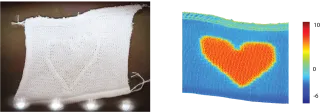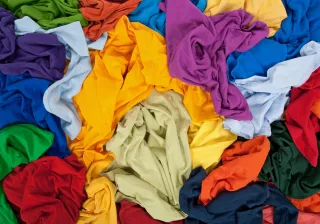Machine vision can distinguish counterfeit and real drugs, healthy and ill plants, and even specific types of rock. It could also offer a solution to the recycling of waste textiles.
The composition of textile fibres determines the suitable recycling method. Melting, chemical dissolution and mechanical processing are all potential alternatives, but their use is limited by inadequacies in the collection and sorting of waste textiles. Most of the world's textile waste currently ends up in landfills or in waste incinerators.
By 2025 EU member states will be required to separately collect textile waste. It is important that by then we are also able to sort the collected textiles.
Machine vision can keep up with a conveyor belt
The composition of textile fibres can be determined by cutting a piece from the cloth and taking it to a laboratory. This does not help if hundreds of tons of textile waste are dumped at a sorting centre every day. We need a method to determine the composition of the fibres on a moving conveyor belt. This can be achieved with a hyperspectral camera that takes images of everything that moves on the conveyor. The images can then be processed with an algorithm to reveal if the collars of a cotton jacket contain polyester, and what is the dominant fibre in fibre mixtures.
This is how machine vision works. It can distinguish counterfeit and real drugs, healthy and ill plants, and even specific types of rock. We are now studying the degree to which it can distinguish the fibres that dominate the textile market, cotton and polyester, and their various mixtures from each other.
An ordinary digital camera divides an image into pixels and measures the radiation reflected from an object in each individual pixel. Three visible wavelengths are commonly used, red, blue, and green, and by combining them familiar multicolour photos are generated. Meanwhile, a hyperspectral camera can measure an entire spectrum of wavelengths in each pixel. The spectrum works as a sort of a chemical fingerprint containing information on the composition of the sample. Usually dozens, or even hundreds of wavelengths are used in the visible or infra-red range. This is roughly equivalent to obtaining hundreds of individual images on different wavelengths.
Accuracy increases by analysing the samples
For a hyperspectral image to reveal the composition of a textile, it needs to be compared with images of textiles with known composition. Therefore, we record images of samples and verify their composition through chemical methods. With the help of these samples we can teach the image processing and mathematical modelling algorithms to identify different fibre mixtures.
We generally use the term chemometrics when combining applied mathematics and statistical methods with chemical research. In any case, the result is a machine vision application, which combines the camera hardware with a software algorithm to recognize textile fibres or predict their properties.
Chemical analysis of textile samples is so time-consuming that it can dictate the pace of our development work. Earlier projects in the textile field have classified samples roughly as cotton, polyester, and mixtures of the two.
This level of detail will not be enough in the future. It would be good if we could recognise aspects such as the composition of fibre mixtures, whether cellulose in the fabric comes from natural or artificial fibres, and what kind of condition the polymers in the fibres are in after possibly numerous rounds of recycling. Machine vision can achieve this if we manage to teach it.

A colour image of a textile sample (left) and the respective chemical differences based on a hyperspectral image (right). The colouring on the right is arbitrary and simply illustrates the chemical differences between the image pixels using principal components analysis.









